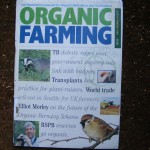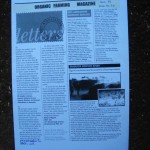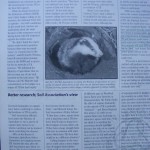I wrote this letter about management of stable manure for the Soil Association’s magazine in 1999. When the magazine was released I saw there was an article on the same double page entitled ’Better research: The Soil Association’s view.’
The thrust of Howard’s research was to create conditions on the farm for the transfer of TB and other diseases to be minimised by his fertility making practises. Howard proved in his title Farming and Gardening for Health or Disease that he was able to control the spread of Foot and Mouth Disease by his fertility making practises My article
is exactly upon this subject and posted on the same page as this article, on the need for better research….The whole point of Howard’s work was greatly misunderstood in 1999 and It is still is today. There is a direct correlation between these two articles. This on farm fertility making programme still continues to be the brunt of my work to the present day:
My specialist organic studies include different cattle shed management systems for farmers around the world. I have studied and tested the Indore Cattle shed Management System devised by Sir Albert Howard, ‘The Grandfather of Organic Farming’ , in India. The system was named after the area in which he was working namely Indoor.
I am an independent consultant to six farms in Europe and a large urban project in West Bengal and have completed and documented composting trials with this system of daily cattle shed management. Sir Albert states that 15% of nitrogen is lost through normal cattle shed management and that further losses occur in mismanaged manure heaps: I would estimate that as much as 25% of valuable nitrogen could be lost.
Defects in manure heaps include leaching by rain; drying out by neglect and subsequent loss of nutrients by evaporation; no air incorporation by the common system of management – The Lincoln system – and the subsequent neglect of the heap in the composting process.
To avoid this loss, first add 30% green matter to the animal bedding and then remove the soiled evenly mixed bedding daily. This should be removed to a properly made compost windrow. If the straw bedding is initially laid down with 30% green matter – either fresh green fodder or simply cut weeds which are withered but not wilted – the correct formula will be underway for a balanced nitrogenous fertiliser. Richard Higgins IECCT Ltd., Borehamwood, Hertfordshire.
Organic Framing welcomes letters (which may be edited for reasons of space or clarity). Write to: Soil Association, Bristol House, 40-56 Victoria Street, Bristol BS1 6BY.
The article was edited quite substantially.
Article on the opposite page of this magazine
Livestock on organic dairy farms could help reduce the incidence of TB in cattle. Soil Association officials have asked the Ministry of Agriculture to run a survey of organic dairy farms to see whether anything can be learned about controlling the disease.
MP’s on the House of Commons Select Committee investigating Bovine TB back the idea after the Soil Association gave them evidence. The National Federation of Badger Groups has welcomed the Association’s plan and said more should be done to research husbandry techniques.
‘Organic diary farmers will have to think very hard before they become involved in the trials,’ said Richard Young, the Soil Association’s adviser. “If they have a nice square farm with a ring fence and TB free herd, they’ll want to hang on to their badgers to keep others out. If they have a long straggly farm with sets in common with farms which have TB, then they might be in a different situation.
Culling badgers in the trial areas could cause a massive migration of badgers from further afield to fill vacant sets, spread infection around the country and cause fresh outbreaks. “The culling programme could make things worse, but it is probably a necessary evil.” said Mr. Young.
Artthhur Pullin keeps 98 cattle of different ages at Woodford Green Farm near Berkeley in G|loucestershire. Mr. Pullin thinks the effect of organic husbandry on the spread of TB is “minimal” – and Henry Bagenal who keeps 115 cattle on an organic farm near Axbridge in Somerset agrees with him “I do not think it is anything the movement should highlight because the risks of an organic farm falling to TB are too high. As a society we kill animals and and it is in our interest to kill badgers because they appear to spread TB which has serious consequences for the human population and more particularly for farmers.”
Philip Marsh, Mr. Pullins vet and a partner in the Rowe Veterinary Group said the lower stocking densities on organic farms could reduce the chances of exposing cattle to badgers. “In dry weather on a dairy farm, grass growth is restricted and cows are more indiscriminate about their grazing so they are more likely to move into areas of badger activity. If grazing is looking tight then it is wise to use supplementary feed to reduce contact with badgers.”
Husbandry methods are already being examined in the TB 99 survey run by the Ministry which compares farms where there has been a TB breakdown with others where there has been no breakdown. About 100 farms from one of the trial areas will be compared with 100 others across the country and farmers will be asked detailed questions about cattle management, crop rotations, maize silage, dirty water systems and many other practices.
Conclusion
Howard did that ‘better research’ 100 years ago.
It was not suggested that they look into the method of fertility making each farmer was employing. This is critical according to Howard’s understanding of animal husbandry.
It should not be that if you are short of fodder you bring it in from else where. This is a fundamental mistake in farming today. There is no telling what kind of soil imported fodder has been grown on. It may be cheap, but that implies that it has been grown with the expedience of chemical fertilisers, pesticides and fungicides etc., which as we know from Howard’s work kill soil organisms. Therefore the life in the soil is too low to support a healthy fodder crop. The only way, modern farming knows, to keep the pests and diseases from ravaging a crop is by spraying with these toxic chemicals. Every farmer should be growing his own fodder with the utmost care to ensure a humus filled soil is the basis of his fodder production. This is what will build immunity in our herds and curb the outbreak and spread of these diseases.
I attended the Elm Farm Research Centre in Berkshire around that time and found that their composting bays were composting single materials. IE., there was one bay of just stable manure piled up high, about 6 or 7 feet and another of crop wastes. There was a leachate running off at the back of this bay. I later reported this to the Director, Mr. Wolf, who told me “This should never be going on.”
So incorrect management of manure is a very serious issue and should be addressed immediately. I have not seen one farm organic or otherwise in the UK that I have visited that is composting properly. There should be no run off (leachate) at any time with proper composting and if there is, it is a signal that anaerobic composting is taking place and a smell is very apparent. Action should be taken at once to correct this as per the HH -2 method as described on this web site and there will be no smell, flies or other vermin problems.
The case against anaerobic digestors
Every so many years it is reported on the news that someone has fallen into a slurry tank (anaerobic digestor) and couldn’t get out. Members of the family have jumped in to rescue them and all have been overcome with fumes and have died. No one has ever died falling into a compost heap, as far as I know. The aerobic method of composting farm waste is safe and produces a pathogen free soil conditioner and a fertiliser in 90 days and it costs far less to install and operate: It doesn’t produce any methane and can be safely used to dispose of all manner of other organic wastes… see more The equipment needed for this operation is that which is found already on farm and the labour required is also no more.



